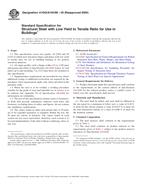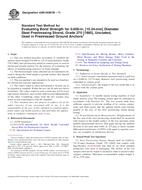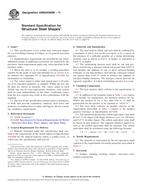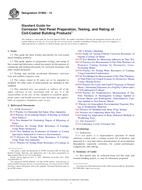Potřebujeme váš souhlas k využití jednotlivých dat, aby se vám mimo jiné mohly ukazovat informace týkající se vašich zájmů. Souhlas udělíte kliknutím na tlačítko „OK“.
ASTM E1681-03(2013)
Standard Test Method for Determining Threshold Stress Intensity Factor for Environment-Assisted Cracking of Metallic Materials
Automaticky přeložený název:
Standardní zkušební metoda pro stanovení prahové hodnoty intenzity stresu faktorem pro životní prostředí asistované praskání kovových materiálů
NORMA vydána dne 15.10.2013
Informace o normě:
Označení normy: ASTM E1681-03(2013)
Poznámka: NEPLATNÁ
Datum vydání normy: 15.10.2013
Kód zboží: NS-42629
Počet stran: 13
Přibližná hmotnost: 39 g (0.09 liber)
Země: Americká technická norma
Kategorie: Technické normy ASTM
Kategorie - podobné normy:
Anotace textu normy ASTM E1681-03(2013) :
Keywords:
aqueous agressive environment, constant-force test, elastic stress, environment-assisted cracking, metallic materials, threshold stress intensity factor, ICS Number Code 91.080.10 (Metal structures)
Doplňující informace
| Significance and Use | ||||||||||||||||
|
5.1 The parameters K5.1.1 The apparent K5.1.2 The degree to which force deviations from static tensile stress will influence the apparent K5.1.3 In some material/environment combinations, the smaller the specimen, the lower the measured K5.1.3.1 The user may optionally determine and report a KEAC value or a KIEAC value. The specimen size validity requirements for a KEAC value meet the size requirements developed for Test Method E647 to achieve predominately elastic behavior in the specimen. Test Method E647 size requirements for compact specimens should be applied to both the compact specimen and the beam specimen. The specimen size validity requirements for a KIEAC value meet the size requirements developed for plane strain conditions for Test Method E399. 5.1.4 Evidence of environment-assisted crack growth under conditions that do not meet the validity requirements of 7.2 may provide an important indication of susceptibility to environmental cracking but cannot be used to determine a valid KEAC value (14). 5.1.5 Environment-assisted cracking is influenced by both mechanical and electrochemical driving forces. The latter can vary with crack depth, opening, or shape and may not be uniquely described by the fracture mechanics stress intensity factor. As an illustrative example, note the strong decrease reported in KISCC5 with decreasing crack size below 5 mm for steels in 3 % NaCl in water solution 5.1.6 Not all combinations of material and environment will result in environment-assisted cracking. In general, susceptibility to aqueous stress-corrosion cracking decreases with decreasing material strength level. When a material in a certain environment is not susceptible to environment-assisted cracking, it will not be possible to measure K5.1.6.1 In research and development, valid K5.1.6.2 In service evaluation, valid K5.1.6.3 In acceptance and quality control specifications, valid KEAC or KIEAC data can be used to establish criteria for material processing and component inspection. 5.1.7 Test results will be affected by force relaxation in constant displacement bolt-loaded compact specimens for some material/environment conditions. For relatively low strength material, non-agressive environments, or high test temperatures, force relaxation can occur independently from environment-assisted cracking. Significant force relaxation would make cracking results difficult to interpret. If force relaxation is suspected of influencing the data, the following trial specimen test is recommended. Test a trial specimen with all the test conditions of interest, except with no environment applied. Monitor the force on the sample using a bolt with an electronic load cell attached. Instrumented bolts of this type are commercially available. A force relaxation of more than 5 % after 24 h indicates that the constant displacement test method may not be suitable for these test conditions, and a constant force test should be considered. 5.1.8 Residual stresses can have an influence on environment-assisted cracking. The effect can be significant when test specimens are removed from material in which complete stress relief is impractical, such as weldments, as-heat-treated materials, complex wrought parts, and parts with intentionally produced residual stresses. Residual stresses superimposed on the applied stress can cause the local crack-tip stress-intensity factor to be different from that calculated from externally applied forces or displacements. Irregular crack growth during precracking, such as excessive crack front curvature or out-of-plane crack growth, often indicates that residual stresses will affect the subsequent environment-assisted crack growth behavior. Changes in the zero-force value of crack-mouth-opening displacement as a result of precrack growth is another indication that residual stresses will affect the subsequent environment-assisted crack growth. 5.1.9 For bolt loaded specimens, the user should realize that material being tested at an non-ambient temperature may have a different displacement-to-force ratio from that at ambient temperature, and also the bolt material may have a different coefficient of thermal expansion from that of the material being tested. Care should be taken to minimize these effects. |
||||||||||||||||
| 1. Scope | ||||||||||||||||
|
1.1 This test method covers the determination of the environment-assisted cracking threshold stress intensity factor parameters, KIEAC and KEAC, for metallic materials from constant-force testing of fatigue precracked beam or compact fracture specimens and from constant-displacement testing of fatigue precracked bolt-load compact fracture specimens. 1.2 This test method is applicable to environment-assisted cracking in aqueous or other aggressive environments. 1.3 Materials that can be tested by this test method are not limited by thickness or by strength as long as specimens are of sufficient thickness and planar size to meet the size requirements of this test method. 1.4 A range of specimen sizes with proportional planar dimensions is provided, but size may be variable and adjusted for yield strength and applied force. Specimen thickness is a variable independent of planar size. 1.5 Specimen configurations other than those contained in this test method may be used, provided that well-established stress intensity calibrations are available and that specimen dimensions are of sufficient size to meet the size requirements of this test method during testing. 1.6 This standard does not purport to address all of the safety concerns, if any, associated with its use. It is the responsibility of the user of this standard to establish appropriate safety and health practices and determine the applicability of regulatory limitations prior to use. |
||||||||||||||||
| 2. Referenced Documents | ||||||||||||||||
|
Podobné normy:
Historická
1.10.2009
Historická
1.4.2011
Historická
1.5.2011
Historická
1.11.2013
Doporučujeme:
Aktualizace zákonů
Chcete mít jistotu o platnosti užívaných předpisů?
Nabízíme Vám řešení, abyste mohli používat stále platné (aktuální) legislativní předpisy.
Chcete vědět více informací? Podívejte se na tuto stránku.



 ASTM A1043/A1043M-05..
ASTM A1043/A1043M-05.. ASTM A981/A981M-11..
ASTM A981/A981M-11.. ASTM A992/A992M-11..
ASTM A992/A992M-11.. ASTM D7893-13
ASTM D7893-13
 Cookies
Cookies
